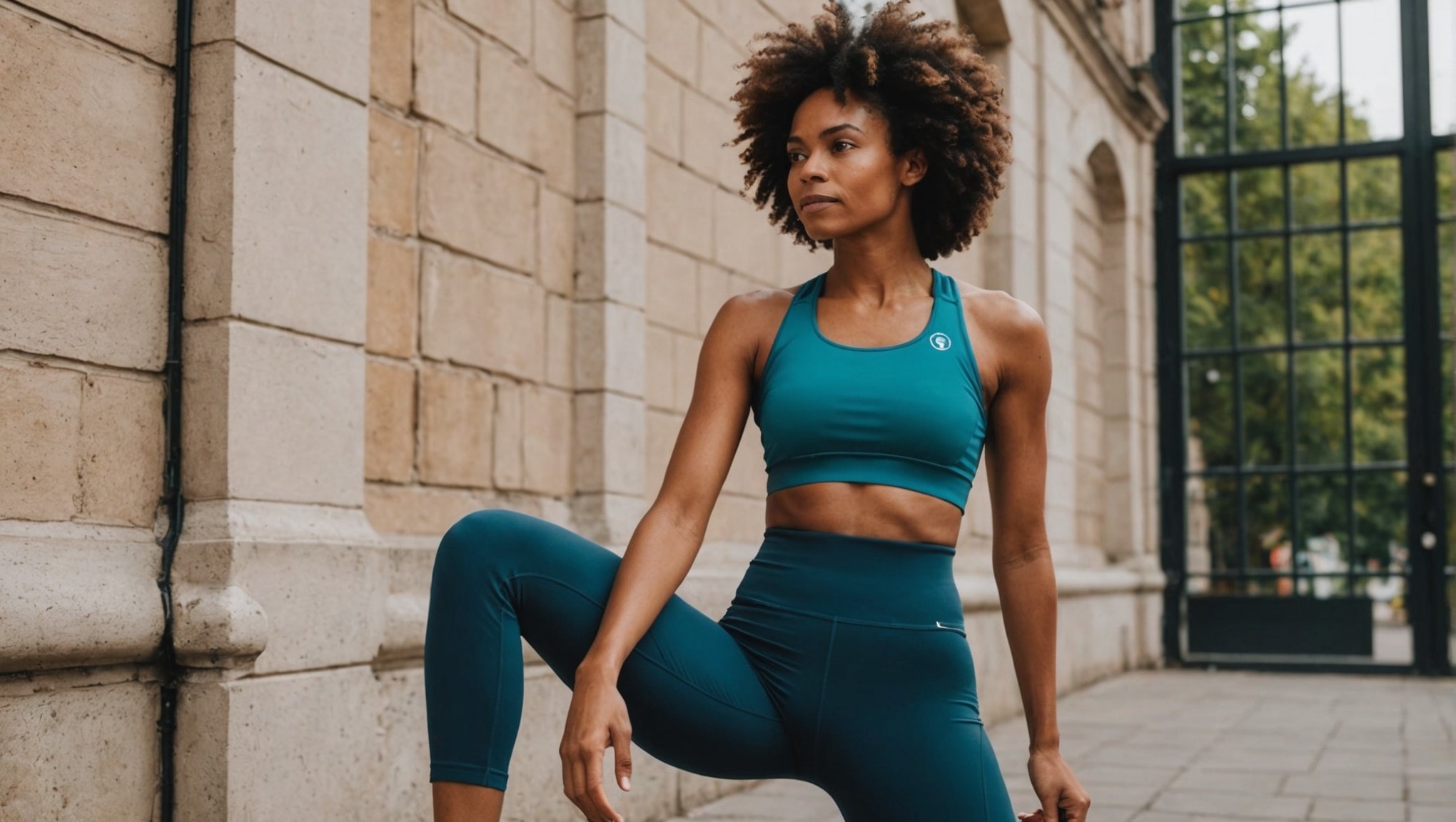Sustainable fashion is no longer just a trend; it's a movement that empowers conscious consumers. The rise of eco-friendly activewear presents choices that benefit both our planet and our health. Selecting sustainable fabrics not only reduces environmental impact but also enhances performance. This guide explores the top sustainable fabrics available in the UK, helping you make informed decisions that reflect your values without sacrificing style or comfort. Discover how to elevate your activewear wardrobe while promoting a greener future.
Overview of Sustainable Fabrics for Activewear
In today's world, the shift towards sustainable fabrics in the activewear industry is gaining momentum. This transition is driven by both environmental concerns and consumer demand for eco-friendly activewear. Understanding the significance of these materials can help consumers make more informed choices.
Also read : Unlock your style: why techwear bodysuits are a must-have
Definition and Importance of Sustainable Fabrics
Sustainable fabrics are materials produced with minimal environmental impact. They often incorporate recycled fibers or are made from renewable resources. These fabrics are designed to reduce waste and pollution, making them a cornerstone in the production of eco-friendly activewear. The importance of these materials lies not only in their reduced carbon footprint but also in their ability to meet the rising ethical standards of consumers.
Overview of the Activewear Market in the UK
The activewear market in the UK is a vibrant and evolving sector. With an increasing focus on health and wellness, consumers are seeking products that align with their values. The demand for sustainable fabrics has led to innovations in material technology, providing a range of options from organic cotton to recycled polyester. This shift not only caters to environmental concerns but also meets the performance needs of activewear enthusiasts.
Additional reading : Explore budget-friendly techwear jackets for all your outings
Benefits of Choosing Sustainable Materials
Opting for sustainable fabrics in activewear offers several advantages:
- Environmental Impact: Reduces pollution and conserves resources.
- Durability: Often more robust, extending the lifespan of garments.
- Consumer Appeal: Aligns with ethical and eco-conscious consumer values.
A quote from a recent study highlights this trend: "Consumers are increasingly prioritizing sustainability in their purchasing decisions, particularly in the activewear sector."
By choosing eco-friendly activewear, individuals contribute to a more sustainable future while enjoying high-quality, performance-driven products.
Types of Sustainable Fabrics
Exploring the various types of sustainable fabrics is essential for understanding their role in creating eco-friendly textiles. These materials not only support environmental goals but also provide unique properties suitable for activewear.
Organic Cotton
Organic cotton is a popular choice among eco-friendly textiles due to its natural cultivation process, which avoids harmful pesticides and fertilizers. This sustainable fabric is soft and breathable, making it ideal for activewear. The environmental impact of organic cotton is significantly lower than conventional cotton, as it uses less water and supports biodiversity. Its compatibility with activewear lies in its comfort and moisture-wicking properties, providing a pleasant experience for users.
Recycled Polyester
Recycled polyester is a standout among types of sustainable fabrics. It is produced by repurposing plastic waste, such as PET bottles, into new fibers. This process reduces landfill waste and conserves resources, aligning with the principles of eco-friendly textiles. Recycled polyester retains the strength and durability of traditional polyester, making it suitable for high-performance activewear. Its ability to withstand rigorous activities while maintaining shape and color fastness is a testament to its practicality.
Tencel/Lyocell
Tencel, also known as Lyocell, is a sustainable fabric made from wood pulp. It is celebrated for its closed-loop production process, which minimizes waste and emissions. This fabric is biodegradable and sourced from sustainably managed forests, emphasizing its environmental benefits. Tencel's suitability for activewear comes from its excellent moisture management and soft touch, offering both comfort and performance. Its versatility in blending with other fibers enhances its appeal in the activewear market.
- Characteristics: Soft, durable, moisture-wicking
- Environmental Impact: Low water usage, reduced emissions
- Suitability for Activewear: High performance, comfort, and sustainability
A quote from a textile expert underscores this: "The shift towards sustainable fabrics like Tencel and recycled polyester is not just a trend but a necessary evolution in the textile industry."
By understanding these types of sustainable fabrics, consumers can make informed decisions that support both their lifestyle and the planet.
Comparative Analysis of Sustainable Fabrics
Exploring the nuances of sustainable fabric analysis reveals the diverse benefits and challenges associated with each type. This understanding is crucial for consumers seeking high-performing eco-friendly activewear options.
Durability and Performance in Activewear
When comparing sustainable fabrics, durability is a key factor. Recycled polyester stands out due to its ability to withstand rigorous activities, maintaining its shape and color over time. In contrast, organic cotton offers a softer touch but may not match polyester's resilience in high-intensity workouts. Tencel/Lyocell strikes a balance, providing both durability and a luxurious feel, making it a versatile choice for various activewear designs.
Moisture-Wicking and Breathability Properties
The performance of sustainable fabrics in terms of moisture management is a critical consideration for activewear. Tencel/Lyocell excels with its superior moisture-wicking abilities, keeping users dry and comfortable. Organic cotton is naturally breathable, offering comfort in less strenuous activities, while recycled polyester provides effective moisture control, ideal for high-performance needs. This balance of properties ensures that each fabric can cater to specific activewear requirements.
Comparison of Environmental Impacts
Understanding the environmental implications of each fabric is essential for a comprehensive fabric comparison. Organic cotton is celebrated for its low water usage and absence of harmful chemicals. Recycled polyester significantly reduces plastic waste, contributing to resource conservation. Tencel/Lyocell offers a closed-loop production process, emphasizing minimal waste and emissions. These factors collectively highlight the environmental benefits of choosing sustainable fabrics.
- Durability: Recycled polyester > Tencel/Lyocell > Organic cotton
- Moisture Management: Tencel/Lyocell > Recycled polyester > Organic cotton
- Environmental Impact: Organic cotton > Tencel/Lyocell > Recycled polyester
A textile expert notes, "The choice of sustainable fabric depends on the specific needs of the consumer, balancing performance with environmental responsibility." This comparative analysis empowers consumers to make informed decisions, aligning their activewear choices with both performance and sustainability goals.
Eco-Friendly Activewear Brands in the UK
In the UK, several sustainable activewear brands are leading the charge in eco-friendly fashion. These brands are not only committed to providing high-quality products but also to implementing environmental practices that minimize their ecological footprint.
Leading Brands Prioritizing Sustainability
Sustainable activewear brands in the UK are making significant strides towards eco-friendly fashion. Among them, brands like BAM, Finisterre, and Patagonia stand out for their dedication to sustainability. These companies have integrated environmentally conscious practices into their operations, from sourcing materials to manufacturing processes.
- BAM: Specializes in bamboo clothing, offering breathable and biodegradable activewear.
- Finisterre: Focuses on ocean-friendly products, using recycled and organic materials.
- Patagonia: Known for its commitment to environmental activism and sustainable practices.
Overview of Product Offerings and Materials Used
These UK brands offer a diverse range of eco-friendly fashion options. BAM uses bamboo fibers, which are naturally soft and sustainable. Finisterre incorporates recycled polyester and organic cotton into their designs, ensuring durability and comfort. Patagonia is renowned for its use of recycled materials and innovation in fabric technology.
| Brand | Key Materials | Product Focus |
|---|---|---|
| BAM | Bamboo fibers | Breathable activewear |
| Finisterre | Recycled polyester, organic cotton | Ocean-friendly clothing |
| Patagonia | Recycled materials | Outdoor and performance gear |
Brand Commitments to Environmental Practices
The commitment to environmental practices is a hallmark of these sustainable activewear brands. BAM invests in reducing water usage and chemical-free processes. Finisterre is dedicated to reducing plastic waste and supporting marine conservation. Patagonia has a robust repair and reuse program, encouraging consumers to extend the life of their garments.
A quote from a brand representative emphasizes this commitment: "Our mission is to create the best product with no unnecessary harm, using business to inspire solutions to the environmental crisis." This dedication ensures that consumers can trust these brands to deliver eco-friendly fashion that aligns with their values.
Sourcing Sustainable Fabrics
Navigating the landscape of eco-friendly sourcing is crucial for those committed to sustainable practices in the activewear industry. Understanding where to buy sustainable fabrics and ensuring transparency in sourcing can significantly impact the environmental footprint of your products.
Recommended Suppliers and Marketplaces in the UK
Finding reliable fabric suppliers in the UK can be a game-changer for businesses and consumers alike. Some of the reputable suppliers include:
- Offset Warehouse: Known for its wide range of ethically sourced fabrics, including organic cotton and recycled polyester.
- Green Fibres: Offers a selection of organic and natural textiles, emphasizing minimal environmental impact.
- The Sustainable Angle: Provides innovative materials that focus on sustainability and performance.
These suppliers are recognized for their commitment to eco-friendly sourcing, providing transparency in their supply chains and ensuring that consumers can trust the origins of their materials.
Tips for Identifying Genuinely Sustainable Fabrics
To make informed decisions, it is essential to recognize genuinely sustainable fabrics. Here are some tips to guide your choices:
- Look for certifications such as GOTS (Global Organic Textile Standard) or OEKO-TEX, which confirm the ecological and social criteria of the fabric.
- Verify the transparency of the supplier's sourcing practices, ensuring they disclose the origins and production processes of their materials.
- Prioritize recycled and organic options, as these typically have a lower environmental impact compared to conventional fabrics.
Understanding these aspects can help differentiate between truly sustainable options and those that merely claim to be so, enhancing the integrity of your eco-friendly sourcing efforts.
Importance of Transparency in Sourcing
Transparency in sourcing is not just a buzzword; it is a fundamental aspect of eco-friendly sourcing. It allows consumers and businesses to trust that their sustainable fabrics are genuinely contributing to a positive environmental impact. A textile industry expert emphasizes, "Transparency in the supply chain is essential for building consumer trust and ensuring the sustainability of products." By demanding transparency, buyers can hold suppliers accountable, fostering a more sustainable and ethical industry.
Care Tips for Sustainable Activewear
Proper care for activewear not only extends the life of your garments but also supports sustainable practices. Understanding the best methods for maintaining sustainable fabrics can make a significant difference in their longevity and environmental impact.
Best Practices for Washing and Drying Sustainable Fabrics
Taking care of activewear begins with mindful washing and drying techniques. Use cold water and a gentle cycle to preserve fabric integrity and reduce energy consumption. Avoid using fabric softeners, as they can coat the fibers, reducing their moisture-wicking properties. When it comes to drying, air drying is preferable. It minimizes wear and tear from high heat, which can degrade the sustainable fabrics over time. If a dryer is necessary, use a low heat setting.
Tips for Prolonging the Life of Activewear
To ensure your activewear remains in top condition, consider these simple yet effective strategies:
- Rotate your garments to prevent excessive wear on any single piece.
- Spot clean stains promptly to avoid the need for frequent washes.
- Store in a cool, dry place to prevent mildew and odors.
These practices help maintain the performance and appearance of sustainable fabrics, ensuring they remain durable and functional.
Impact of Care Practices on Sustainability
The way you care for your activewear significantly influences its sustainability. Proper maintenance reduces the frequency of replacement, decreasing overall consumption and waste. According to a textile expert, "The longevity of sustainable fabrics is closely tied to how they are cared for. Thoughtful practices can greatly reduce their environmental footprint." By adopting these sustainable laundry practices, you contribute to a more eco-friendly lifestyle and support the broader goals of sustainability.
Consumer Reviews and Expert Opinions
Understanding the landscape of sustainable fabric reviews is essential for making informed choices in the activewear market. Consumers and experts alike provide valuable insights into the performance and appeal of these eco-friendly materials.
Summary of Consumer Experiences
Consumers have shared varied experiences with sustainable activewear, highlighting both the benefits and challenges. Many users appreciate the durability and comfort of these fabrics, noting that they often outperform traditional materials in terms of longevity and wearability. However, some have pointed out issues such as higher price points and limited availability, which can be a barrier for widespread adoption.
- Pros: Durability, comfort, eco-friendly
- Cons: Cost, availability
Expert Recommendations on Fabric Choices
Experts in the textile industry recommend prioritizing sustainable fabrics that offer a balance of performance and environmental benefits. Recycled polyester is often praised for its strength and moisture-wicking properties, making it ideal for high-intensity activities. Tencel/Lyocell is recommended for its soft touch and biodegradability, suitable for those seeking both comfort and sustainability. Experts suggest that consumers consider their specific needs and preferences when selecting fabrics.
"Choosing the right sustainable fabric involves understanding both its environmental impact and its suitability for intended use," notes a textile expert.
Analysis of Trends in Consumer Preferences
There is a noticeable trend towards sustainability in consumer preferences, with many actively seeking out eco-friendly activewear options. This shift is driven by a growing awareness of environmental issues and a desire to reduce personal carbon footprints. As more brands offer sustainable fabrics, consumers are increasingly prioritizing these options over conventional ones, despite potential cost differences.
| Consumer Preference | Trend |
|---|---|
| Eco-friendly options | Rising |
| Conventional fabrics | Declining |
By examining these sustainable fabric reviews and expert insights, individuals can make informed decisions that align with both their lifestyle needs and environmental values.











